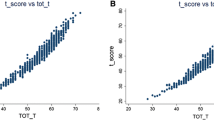Abstract
A Japanese translation of the Childhood Autism Rating Scale (CARS) (the Tokyo version of the CARS, CARS-TV) was used with 167 developmentally disabled children under age 16. Cronbach's coefficient alpha was 87. The interrater reliability (r) for each of the 15 scales based on 128 children ranged from .43 to .77 with an average of .62. Based on the 167 children, the total CARS-TV score demonstrated a satisfactory level of taxonomic validity (Thorndike, 1982) on DSM-III diagnostic groups. The total score discriminated infantile autism and other pervasive developmental disorders more efficiently from mental retardation without an additional diagnosis of pervasive developmental disorder than an IQ. The total score also showed a satisfactory concurrent validity on the overall rating of autism.
Similar content being viewed by others
References
American Psychiatric Association. (1980).Diagnostic and statistical manual of mental disorders (3rd ed.). Washington, DC: Author.
Parks, S. L. (1983). The assessment of autistic children: A selective review of available instruments.Journal of Autism and Developmental Disorders, 13, 255–267.
Schopler, E. (1985). Jiheishou no shindan [Diagnostic classification: Childhood autism rating scale]. In E. Schopler, J. G. Olley, & M. D. Lansing (Eds.),Jiheishou no chiryoukyouiku program (pp. 35–63). Tokyo: Budo-sha.
Schopler, E., Reichler, R. J., DeVellis, R. F., & Daly, K. (1980). Toward objective classification of childhood autism: Childhood autism rating scale (CARS).Journal of Autism and Developmental Disorders, 10, 91–103.
Schopler, E., Reichler, R. J., & Renner, B. R. (1986).The childhood autism rating scale (CARS) for diagnostic screening and classification of autism. New York: Irvington.
Shimizu, Y., Senda, S., Someya, R., Ohta, M., & Kawasaki, Y. (1987). Jiheishouji niokeru DQ to IQ tono kankei [Correlation between DQ and IQ in autistic children of pre-school age].Japanese Journal of Psychiatric Treatment, 2, 61–67.
Takagi, H., Yanai, H., Hattori, Y., Ichikawa, M., Sato, S., & Marui, E. (1987).High quality analysis libraries for business and academic users [Computer program]. Kyoto: Gendaisugaku-Sha.
Teal, M. B., & Wiebe, M. J. (1986). A validity analysis of selected instruments used to assess autism.Journal of Autism and Developmental Disorders, 16, 485–494.
Thorndike, R. L. (1982). Group membership as a criterion variable. In R. L. Thorndike (Ed.),Applied psychometrics (pp. 220–222). Boston: Houghton Mifflin.
Author information
Authors and Affiliations
Additional information
This study was supported in part by a grant from the Ministry of Education, Science and Culture of Japan (No. 63480263). The authors thank Dr. E. Schopler for his permission to use a Japanese translation of the CARS in this study.
Rights and permissions
About this article
Cite this article
Kurita, H., Miyake, Y. & Katsuno, K. Reliability and validity of the Childhood Autism Rating Scale-Tokyo version (CARS-TV). J Autism Dev Disord 19, 389–396 (1989). https://doi.org/10.1007/BF02212937
Issue Date:
DOI: https://doi.org/10.1007/BF02212937



